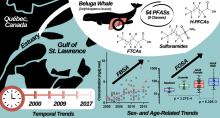| Title | Tissue distribution and maternal transfer of poly- and perfluorinated compounds in Chinese sturgeon (Acipenser sinensis): implications for reproductive risk. |
| Publication Type | Journal Article |
| Year of Publication | 2010 |
| Authors | Peng, H, Wei, Q, Wan, Y, Giesy, JP, Li, L, Hu, J |
| Journal | Environ Sci Technol |
| Volume | 44 |
| Issue | 5 |
| Pagination | 1868-74 |
| Date Published | 2010 Mar 01 |
| ISSN | 0013-936X |
| Keywords | Alkanesulfonic Acids, Animals, Female, Fertility, Fertilization in Vitro, Fishes, Fluorocarbons, Organ Specificity, Reproduction, Risk Factors, Tissue Distribution |
| Abstract | It is critical to investigate the tissue distribution and maternal transfer of poly- and perfluorinated compounds (PFCs) in wild fish for assessing potential effects on ecosystems. Concentrations of 23 PFCs in nine organs and egg were measured in 16 17- to 25-year-old female Chinese sturgeon (Acipenser sinensis, an anadromous fish), that died during propagation. Three polyfluorinated amides were detected in stomach, intestine, and gills and 7:3 FTCA was specifically accumulated in liver. The greatest total concentration of PFCs in egg was 35.1 +/- 10.4 ng/g ww and was predominated by perfluorooctane sulfonate (PFOS) and perfluorotridecanoate acid (PFTriDA). The longer-chain C(11)-C(14) and C(16) perfluorinated carboxylates were more accumulated in Chinese sturgeon than PFOS, partly due to the increasing trends of PFCAs with fish age. Maternal transfer ratios of PFCs expressed as ratios of concentrations in the egg to those in the liver ranged from 0.79 (perfluorooctanoate) to 5.5 (PFTriDA), depending on their carbon chain lengths or protein-water coefficients. The PFOS equivalent of PFC mixtures, calculated by multiplying the relative potency factor of each PFC to PFOS by the corresponding concentration, ranged from 90.6 to 262 ng/g. The hazard quotient was 0.20, implying potential reproductive effects of PFCs on Chinese sturgeon. |
| DOI | 10.1021/es903248d |
| Alternate Journal | Environ. Sci. Technol. |
| PubMed ID | 20143820 |
Environmental Chemical Biology

